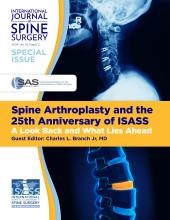ABSTRACT
Background This study evaluates the accuracy, biomechanical profile, and learning curve of the transverse process trajectory technique (TPT) compared to the straightforward (SF) and in-out-in (IOI) techniques. SF and IOI have been used for fixation in the thoracic spine. Although widely used, there are associated learning curves and symptomatic pedicular breaches. We have found the transverse process to be a reproducible pathway into the pedicle.
Methods Three surgeons with varying experience (experienced [E] with 20 years in practice, surgeon [S] with less than 10 years in practice, and senior resident trainee [T] with no experience with TPT) operated on 8 cadavers. In phase 1, each surgeon instrumented 2 cadavers, alternating between TPT and SF from T1 to T12 (n = 48 total levels). In phase 2, the E and T surgeons instrumented 1 cadaver each, alternating between TPT and IOI. Computed tomography scans were analyzed for accuracy of screw placement, defined as the percentage of placements without critical breaches. Axial pullout and derotational force testing were performed. Statistical analyses include paired t test and analysis of variance with Tukey correction.
Results Overall accuracy of screw placement was comparable between techniques (TPT: 92.7%; SF: 97.2%; IOI: 95.8%; P = .4151). Accuracy by technique did not differ for each individual surgeon (E: P = .7733; S: P = .3475; T: P = .4191) or by experience level by technique (TPT: P = .1127; FH: P = .5979; IOI: P = .5935). Pullout strength was comparable between TPT and SF (571 vs 442 N, P = .3164) but was greater for TPT versus IOI (454 vs 215 N, P = .0156). There was a trend toward improved derotational force for TPT versus SF (1.06 vs 0.93 Nm/degrees, P = .0728) but not for TPT versus IOI (1.36 vs 1.16 Nm/degrees, P = .74). Screw placement time was shortest for E and longest for T for TPT and SF and not different for IOI (TPT: P = .0349; SF: P < .0001; IOI: P = .1787) but did not vary by technique.
Conclusions We describe the TPT, which uses the transverse process as a corridor through the pedicle. TPT is an accurate method of thoracic pedicle screw placement with potential biomechanical advantages and with acceptable learning curve characteristics.
Clinical Relevance This study provides the surgeon with a new trajectory for pedicle screw placement that can be used in clinical practice.
- thoracic pedicle screw implantation
- transverse process trajectory technique
- instrumentation
- thoracic spinal deformities
- biomechanical characteristics
- screw placement
- accuracy of placement
- reproducibility
- spine surgeon learning curve
Footnotes
Disclosures and COI: Research grant funding was received by DePuy Synthes Spine, Inc. The work was supported in part by the NSF Industry/University Cooperative Research Center at the University of California at San Francisco, San Francisco, California, and the University of Toledo, Toledo, Ohio. Institutional review board approval was obtained for this study from all participating sites.
- This manuscript is generously published free of charge by ISASS, the International Society for the Advancement of Spine Surgery. Copyright © 2021 ISASS







